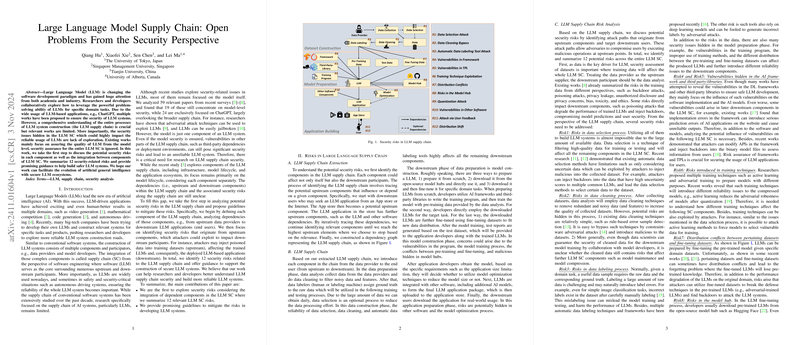Overview of "LLM Supply Chain: Open Problems From the Security Perspective"
This paper addresses a critical yet underexplored aspect of the development and deployment of LLMs—the security challenges throughout the LLM supply chain (LLM SC). It seeks to bridge the knowledge gap by articulating potential security vulnerabilities within each segment of LLM SC and proposing methodologies for mitigating these vulnerabilities. The paper identifies 12 security-related risks associated with LLM SC and suggests strategies to construct safer LLM systems.
Contributions and Findings
The authors have made several significant contributions:
- Comprehensive Risk Analysis: The paper identifies and analyzes 12 distinct security risks inherent in the LLM supply chain. These risks span various stages, from data selection and cleaning to model deployment and user interaction. The articulated risks highlight vulnerabilities that can impact the holistic reliability of LLMs when used in real-world applications.
- Component-Wise Risk Identification: The paper details potential risks associated with different components of the LLM SC, such as:
- Data Preparation: Risks include vulnerabilities in data selection, cleaning procedures, and labeling inaccuracies that could compromise the dataset integrity.
- Model Construction: Discusses risks from vulnerabilities in AI frameworks, distribution conflicts in training data, and potential malevolent elements in model hubs.
- Application Development: Explores risks emerging from model optimization processes and potential backdoors introduced during model compression.
- Security Mitigation Guidelines: The paper provides structured guidelines for enhancing security measures throughout the LLM SC. These include better data construction practices, cautious application of model training techniques, and robust assessment protocols.
Practical Implications and Theoretical Speculations
The paper not only highlights significant vulnerabilities but also underscores the far-reaching implications of these security risks:
- Industry Impact: The security of LLMs is crucial for domains like autonomous driving and other AI-driven sectors where LLMs are increasingly integrated. In these high-stakes applications, even minor security breaches can lead to catastrophic failures.
- Theoretical Advancements: Understanding the dependencies and interactions within LLM SC could lead to the development of more resilient AI architectures that are inherently more secure and trustworthy.
- Future Research Directions: The paper lays a foundation for future studies in LLM SC security, advocating for metrics and techniques to measure and mitigate risks, thus enabling the creation of more dependable LLM-driven applications.
Speculations on Future Developments
Looking forward, advancements in LLM SC security can evolve in several directions:
- Enhanced Data Handling Procedures: Developing sophisticated data selection and cleaning algorithms that are robust against adversarial attacks could significantly reduce upstream risks.
- Secure Model Hub Frameworks: Establishing stronger governance and verification mechanisms for model hubs could prevent the dissemination of vulnerable or malicious models.
- Dynamic Security Evaluations: Implementing continuous and dynamic security assessments throughout the lifecycle of LLMs and associated supply chains could help in early detection and mitigation of emerging threats.
In summary, this paper provides a detailed examination of the previously underexplored security vulnerabilities within the LLM SC. By doing so, it not only alerts researchers and developers to critical threats but also advances the discourse on creating secure, reliable AI systems that can better withstand the complexities and challenges of real-world applications.
